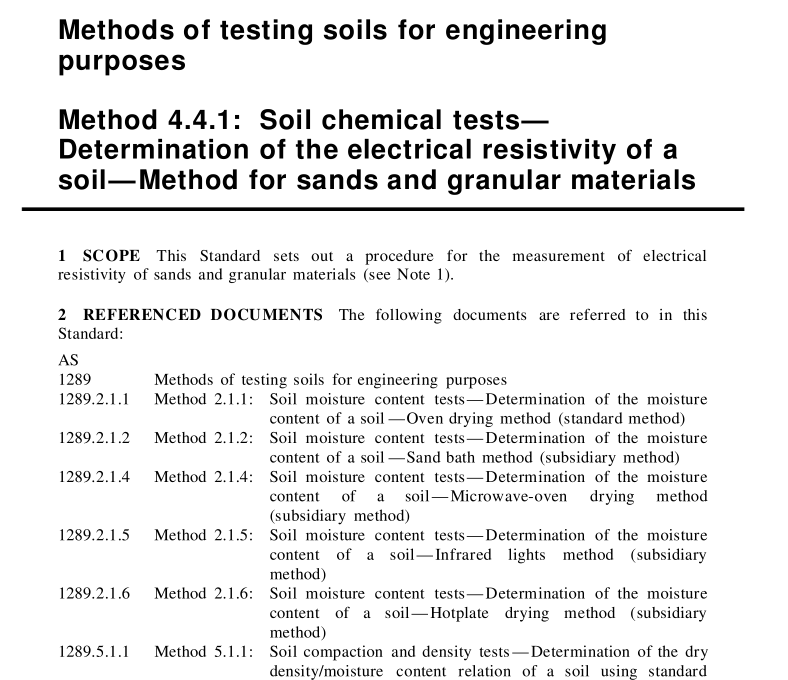AS 1289.4.4.1 pdf download – Methods of testing soils for engineering purposes Method 4.4.1 : Soil chemical tests— Determination of the electrical resistivity of a soil—Method for sands and granular materials

AS 1289.4.4.1 pdf download – Methods of testing soils for engineering purposes Method 4.4.1 : Soil chemical tests— Determination of the electrical resistivity of a soil—Method for sands and granular materials
1 SCOPE This Standard sets out a procedure for the measurement of electricalresistivity of sands and granular materials (see Note 1).
2REFERENCED DOCUMENTS The following documents are referred to in thisStandard:
AS
1289
Methods of testing soils for engineering purposes
1289.2.1.1
Method 2.1.1: Soil moisture content tests—Determination of the moisturecontent of a soil —Oven drying method (standard method)
1289.2.1.2 Method 2.1.2: Soil moisture content tests—Determination of the moisture
content of a soil —Sand bath method (subsidiary method)
1289.2.1.4 Method 2.1.4: Soil moisture content tests—Determination of the moisture
content ofasoil——Microwave-oven dryingmethod(subsidiary method)
1289.2.1.5 Method 2.1.5: Soil moisture content tests—Determination of the moisture
content of asoil——Infrared lights method (subsidiarymethod)
1289.2.1.6 Method 2.1.6: Soil moisture content tests—Determination of the moisture
content of a soil—Hotplate drying method( subsidiarymethod)
1289.5.1.1 Method 5.1.1: Soil compaction and density tests—Determination of the dry
density/moisture content relation of a soil using standardcompactive effort
1289.5.4.1 Method 5.4.1: Soil compaction and density tests—Compaction control
test—Dry density ratio,moisture variation and moistureratio
1289.E5.1 Method E5.1: Soilcompaction and densitytests—Determination of
minimum and maximum drydensityof a cohesionlessmaterial
1289.E6.1 Method E6.1: Soil compaction and density tests—Density index method
for a cohesionless material
3APPARATUS The following apparatus shall be used:
(a)A plastic soil box as shown in Figure 1. The box shall be approximately 220 mm
long with internal dimensions of 40 mm x 30 mm. It shall be fitted with plateelectrodes at each end and potential measurement pins on one side spaced so that
the distance between their axes in centimetres is numerically equal to the cross-sectional area of the box in square centimetres.
(b)An instrument for measuring earth resistance*.4 PROCEDURE The procedure shall be as follows:
(a)Determine the moisture content of the sand or granular material, as delivered to the
laboratory,in accordance with AS 1289.2.1.1,or one of the subsidiary methods2.1.2,2.1.4,2.1.5 and 2.1.6(see Note 2).
(b)Determine the maximum density in accordance with AS 1289.E5.1 or AS 1289.5.1.1
as appropriate and calculate the dry density required by the relevant specification(see Note 3).
Where density is not specified for the project,use a dry density ratio of 90 percent(see AS 1289.5.4.1) or dry density index of 90 percent (see AS 1289.E6.1),asappropriate.
(c)Calculate the mass of sand, as delivered, to be compacted into the mould to produce
the required dry density ratio.Calculate the volume of water required for completesaturation of the sample.
(d)Obtain by quartering or riffling four subsamples of sand or granular material of
about 600 g. From each subsample,take the mass of material sufficient to fill thesoil box.
(e) Place about 75 percent of the additional water required into the soil box (see Note
4).Carefully place the sand or granular materiai into the water in the soil box.Gently tap the soil box to obtain the required density condition. Add remainingwater to the soil box ensuring that as much air as possible is expelled from the sandor granular material.
(f) Connect the four terminals on the soil box to the appropriate terminals on the earth
tester. Take resistance readings on the null indicator at a time of l min afterconnection,and record.
(g)Repeat Steps (e) and (f) for remaining subsamples.
(h) Take the mean of the four values obtained. If any value departs from the mean by
more than 10 percent,obtain another subsample and repeat the procedure.
5 CALCULATION Divide the mean of the four values obtained by 100 to obtain theresistivity of the material, in ohm metres.
6TEST REPORT The following test results and general information shall bereported:
(a) Test results Report the following:
(i) The mean resistivity value in ohm metres to the following accuracy:
(A) Mean resistivity greater than 50 Q.m——report to nearest 5 Q2.m.
(B) Mean resistivity between 10 Q.m and 50 Q.m—report to nearest
2 Q.m.
(C)Mean resistivity less than 10 Q.m—report to nearest 1.0 Q.m.
(ii) The density ratio Rp or density index l, of the material under test,as
appropriate,in percent.









